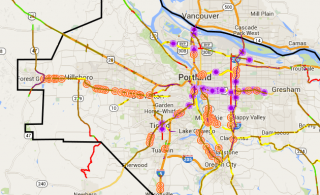As the Oregon Department of Transportation sprints to meet an August grant deadline that could bring federal money to local biking and walking improvements, it’s asking for public input about the deepest needs.
As we wrote in February, this project is part of the state’s first-ever comprehensive list of the existing state of its biking and walking facilities.
If awarded, the federal grants that ODOT applies for after this process will go toward projects being built from 2018-2021.
“If you were going to pick one thing to spend time on in the virtual open house, it’d be the virtual maps tab,” Horning said in an interview Monday. “Write your address in the search box so it’ll zoom to your neighborhood, and just see if that annoying gap in the sidewalk on the ODOT highway by your house, does that show up as red? And if it doesn’t, drop a pin there.”
The maps of biking and walking facilities include such things as a solid red line on Portland’s 82nd Avenue, indicating the lack of any bike facilities there, and 25 missing crossings along Tualatin Valley Highway through Washington County.
Advertisement
Horning also encourages people to check the existing lists of comments about biking and walking facilities and give “thumbs up” votes to problems that they agree with. ODOT hopes this will help the biggest problem spots float to the top.
“If somebody already wrote ‘there’s no bike lane on this bridge, fix the bike lane on this bridge, it’s a priority for me,’ you can just click on the thumbs-up,” Horning said.
ODOT launched the inventory process after coming up completely empty on federal grants for Portland-area active transportation projects to be built from now until 2018. This pilot project in Region 1, which is ODOT’s name for the Portland metro area, may become a model for other parts of the state.
Another component of ODOT’s open house is a brief survey that asks people to help ODOT decide which factors should most important in deciding which projects get built. The current options are crash history, crash risk, transit access, access to essential destinations, service to transportation-disadvantaged populations, filling network gaps and being part of local jurisdictions’ existing plans. Survey takers can also suggest other criteria that the state should consider.



